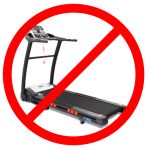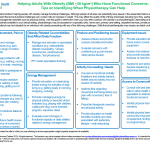The keys to getting local search marketing right for your health, fitness, or wellness business like in just two words:
Local.
Search.
If you’re using any of these:
- Facebook posts
- Your email newsletter
- Blog posts
- Organic SEO tweaks on your website
to reach new prospects in your neighborhood…they’re not hearing you.
Your followers are. Your subscribers are, and maybe even a stranger on the Internet who lives 3000 miles away. But most of the time, those people are either not local or they’re not searching.
Local search marketing has changed
We used to give that list of advice to nearly all of our wellness clients: focus on keywords, write All.The.Posts, capture the email address for the newsletter, and so on. And for a long time, it was good advice that brought them new customers.
Then Google changed how local search worked. Overnight, all those blog posts, backlinks, and keyword-rich websites didn’t amount to a hill of beans.
So what matters now?
Google’s changes give local businesses special treatment
Today, 90%+ of prospects discover their local wellness business via content powered by Google Business Profiles, like the Local 3-Pack, and via Google’s local search Ads. As soon as they click your profile or ad, Google sends people straight to your website to explore your business further and get upfront answers for their showstopper concerns.
What’s more, those are the only things that matter.
Get them right, and you’ll find that search marketing is blessedly simpler for local health clubs, yoga studios and healthy lifestyle programs than it ever used to be. Get them wrong, and you might as well sit back and listen to the crickets.
What doesn’t show up when prospects search for local businesses?
Blog posts and social media posts. Most local business websites. These typically don’t appear at all in the first 10-20 search results. They’re not a factor in lead generation because prospects literally do not even see them.
The Local Marketing Triangle
We call this the Local Marketing Triangle for Health and Wellness, and it really is as simple as 1-2-3.
- Google Ads: Whether or not you pay to advertise your local wellness business, folks who search for “hot yoga near me” are going to see ads first. The job of your ads is to communicate quickly and clearly exactly what you do, for whom, and why those people should check you out.
- Your Google Business Profile: Long ago, this was a simple business directory: name, address, phone. But nowadays, your Business Profile contains specific data that helps Google’s artificial intelligence match searchers to the businesses closest to them who can best meet their needs. Google uses ALL your profile data to dial in a close match, so fill yours out completely.
- Your Website: Yes! Your website still matters! But not because it’s full of keywords. That same Google AI checks out your site to see if people will be happy when they arrive. If your content’s vague about what you do or important details are buried in three layers of menus, Google’s going to recommend another site that’s easier to understand.
Saying the quiet part out loud
Those SEO contractors and online “experts” who say you have to produce a constant flow of fresh blog and social media content in order to get new customers are divorced from the reality of local fitness & wellness businesses.
Fortunately, business owners and marketing managers actually know this at a gut level. They’ll routinely say, “We do all these things we’re supposed to do: post every day on social, our marketing person does the newsletter and we’ve got a contractor who does blog posts, but I really don’t see any sign that it makes a difference.”
They’re right. It doesn’t matter. It isn’t making a difference. The emperor has no clothes.
Blogs and social don’t focus on the needs of people actively looking to buy—so they don’t even show up in Google results when buyers search for local businesses. That’s just how it works.
So who does do well with blogs and social?
Blogs and social work fine for two groups: people who already know you and want an update, and people just starting to explore a particular aspect of health, fitness or wellness.
For the first group, it’s fine to make sure your customer base knows you’re introducing a new product or service. Let ’em know, then move on to the next task on your to-do list. You might upsell or cross-sell them. But they’re already your customers.
The second group? Well…those folks are not remotely close to buying anything, and most never will be. They typically search for information:
- “tips for running in cold weather” (searcher reads RunnersWorld.com article)
- “how to sleep better” (searcher reads MayoClinic.com article)
- “is weight gain hereditary” (searcher reads CDC.gov article)
You see the common thread, right? Huge, popular, and extremely well-known web publishers, non-profits and government organizations have already flooded virtually every health and wellness topic with general-interest posts.
For those megasites, this kind of content is their core business. Their livelihood depends on it, and they’re very good at it. You will never outrank them, and you can pay your own team or hire contractors to write posts like that until the cows come home, but it will never bring you leads.
Why this is perfectly fine
Virtually none of these popular sites compete with your local fitness and wellness business. Most are for-profit content publishers. Their business model depends on selling ads on their sites, selling subscriptions to exclusive content, and partnering with related businesses to promote their products.
We had a client which was a multidisciplinary pain management practice that saw patients in person. They had a top-ranked blog post on at-home DIY back pain treatment. It got thousands of monthly views. None of them were local. Most weren’t even in North America, much less in the state and city where they practiced. There is zero chance they will ever be customers.
He was horrified. We had to reassure him that he was still his hometown’s #1 pain management service.
That was what he should have been promoting in the first place.
So let them do their thing. They’re awakening people to possibilities, educating on really basic principles, helping dispel fundamental myths and misconceptions.
All of this eventually benefits YOUR business, for free. Why spend time and money trying to duplicate their efforts?
Instead, focus on what YOU do best and get the word out in the most effective way possible.
Do only the marketing that matters
People searching for businesses locally are already conditioned to buy. They’re just trying to figure out which business to choose, which one will match their needs and temperament best.
If they had general health and wellness interests, they got that information earlier in their customer journey, mainly from those popular well-known sites we mentioned above.
This is why we tell most local fitness and wellness businesses that they can stop worrying about many of marketing rituals that they diligently execute and privately question.
Your gut check is right! Facebook business pages aren’t going to bring you new customers. Typical blog posts won’t either. Neither will your Instagram posts.
Again, people looking to buy local fitness and wellness services don’t even see that content. They see what’s on the Google search page. That’s it.
Online-only vs local
SEO works very differently for online-only fitness & wellness businesses. Online-only businesses serve people who share a common interest, regardless of location. Think KizenTraining.com, Noom.com or YogaWithAdriene.com.
Online-only businesses don’t have access to unique local tools like Google Business Profile, Google local search Ads, the Local 3-Pack and additional Map and Search placements.
For them, traditional organic search optimization is crucially important.
Unlike your local business, hey can’t easily pinpoint only the people looking to buy at any given moment. So their best bet is to get in front of as many people as humanly possible. At any point in time, a small percentage will be ready to buy, so as long as they get in front of enough people, the business model will work.
They’re also betting that if they can attract people early in their buying process, they’ll be able to stay top of mind with them until they’re actually ready to buy something, and with luck, finally get the purchase.
Keep in mind, though: this only works if enough of the people seeing their web, social & email content end up wanting to buy an online service. If they want in-person programs, the online business has nothing to offer them.
For these businesses, the key to success really is consistently producing lots of web, social and email content for all types of search intent and for all stages of the sales funnel—for folks barely starting to think about a particular aspect of health and wellness all the way through to people ready to click “buy” and purchase their online program, service or app.
They face an additional challenge: their content is often competing against all those web publishers, non-profits, etc, we talked about earlier.
It’s a numbers game. They put money on all the available bets, knowing that some will pay off and some won’t.
The bottom line for local businesses
Optimize your Local Marketing Triangle so you’re marketing to people actively looking to buy, and spend the time you save talking to your paying customers!




